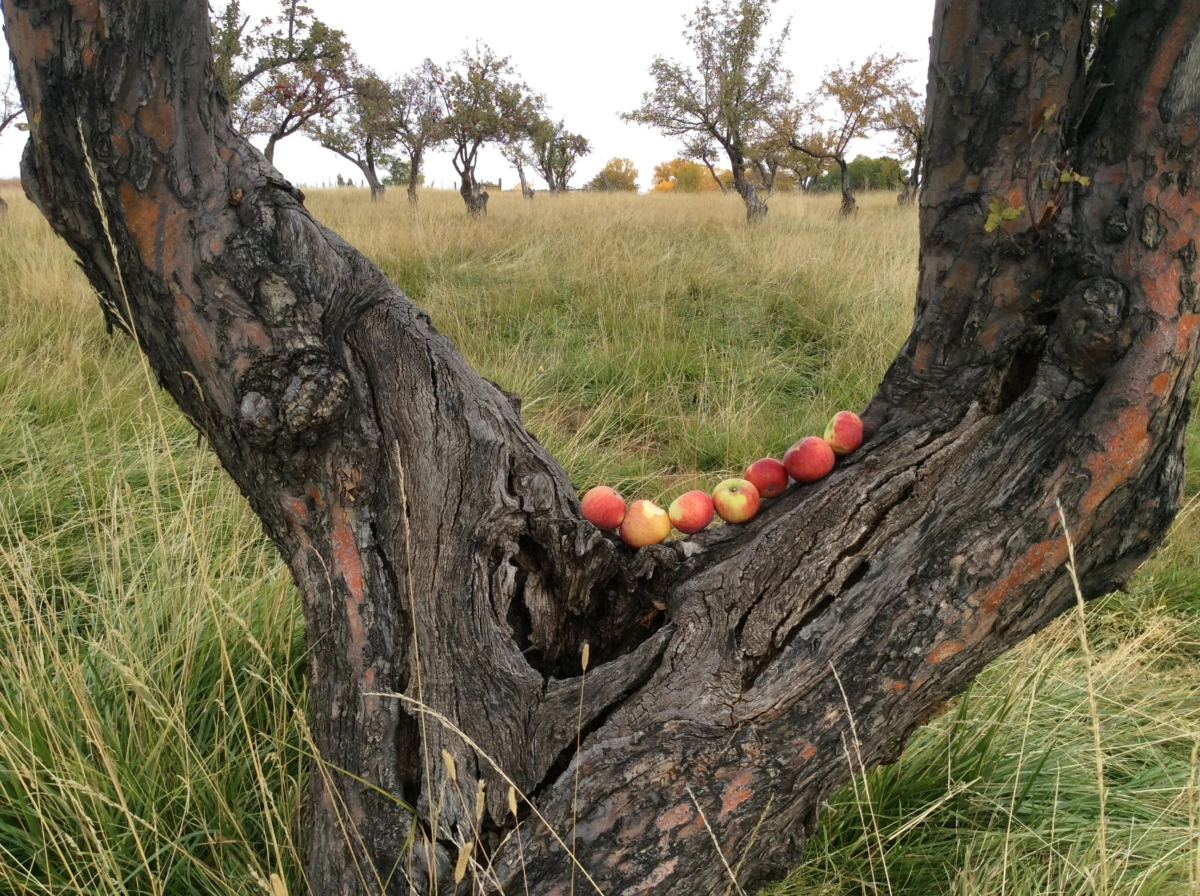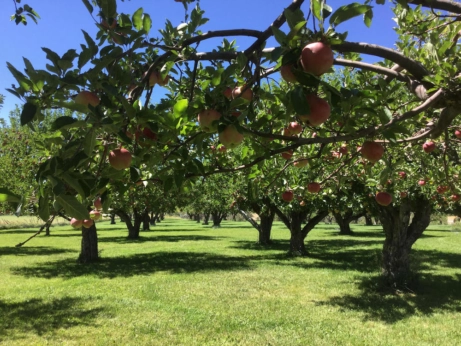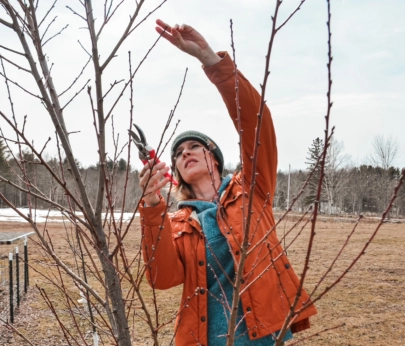The increasing popularity of hard cider means apple trees planted a century ago are being rediscovered and restored.

Wherever you find an old homestead—a house and barn with a little bit of land that has stood from sometime in the 1800s or early 1900s—you’ll find an apple tree. It may be gnarly, with limbs clawing out in all different directions like a witch’s unkempt hair. It may be surrounded by weeds and overgrowth, struggling skyward for the nutrition of the sun. But it will almost certainly be there. You may even find a few trees or an orchard. Even when the homestead has been reduced to the sad pit of a forgotten foundation, an apple tree remains.
The history of the United States is a history lined with apple trees. Early European settlers in America brought with them apple seeds, which they planted to begin the first orchards. Apples were a fruit of survival at the time, storing well and serving as both food and, in the form of cider, drink.
After the Revolutionary War, apples proliferated across the frontier. The legend of Johnny Appleseed is the story of a real man, John Chapman, who planted apple seedlings across what is now Appalachia and north into Ontario, Canada. Most homesteads up and down and across the expanding United States had several apple trees, if not full orchards. They were planted for food, to produce new trees to sell and for the production of hard cider, which was one of the most common drinks consumed in colonial America.
By the 1900s, apples had fallen out of favor. The introduction of prohibition eliminated the market for hard cider, and as railroads transformed transportation across the country, the market changed. Now, a few large apple orchards, growing only one or two varieties of apples, control the apple market. Today, 22 percent of apples sold in US grocery stores are the variety Gala, and most supermarkets offer only a few varieties. The backyard apple tree was left to grow wild—until a recent surge in interest in heritage varieties and hard cider production.
As scraggly and unkempt as an old apple tree may appear, it can still be a stellar start to an orchard or a fruitful addition to a family homestead.
“Planting new trees is going to take some years before they’re mature and fruit bearing,” says Jennifer Ries, who coordinates the tree nursery department at Fedco, a tree and seed cooperative out of Clinton, Maine. “With these old trees, we have gifts from anonymous strangers of the past who planted these trees for particular reasons.”
Old tree discovery and restoration was once the purview of dedicated pomologists such as John Bunker, author of Not Far From the Tree, and Dan Bussey, author of The Illustrated History of Apples in the United States and Canada. Bunker would travel the backroads of Maine and knock on the doors of old farmhouses with peeling paint and sagging roofs. He would scout the property for aging apple trees and, if he found them, collect fruit and cuttings. He has worked to identify more than 500 cultivars in his ongoing career.

A restored orchard of heritage apple trees. (Photo credit: Montezuma Orchard Restoration Project)
But today, it is more than just a few of the apple-obsessed who are discovering and rehabilitating old trees. The surging popularity of hard cider has inspired farmers to revitalize old orchards and plant new ones, and even single backyard trees are benefiting from the renewal.
“We get a lot of emails from cider makers,” says Amy Dunbar-Wallis, a graduate student at the University of Boulder in Colorado and community outreach coordinator for the Boulder Apple Tree Project. “And we hear from homeowners who have apple trees on their land and want to be cider makers.”
Organizations such as the Boulder Apple Tree and nearby Montezuma Orchard Restoration Project, as well as the Maine Heritage Orchard in Maine, the Lost Apple Project in Washington and the Temperate Orchard Conservancy in Oregon, have grown in the past decade to support curious homeowners and passionate arborists alike.
If you have a homestead with an ancient apple tree in the backyard or perhaps a small orchard full of leaning, bending and twisting trees, it is possible to reclaim the productivity of those trees. According to Ries, apple trees can produce bountiful crops for 200 years, so some of those homestead trees may just be getting started.
Identify the tree
You can restore an aging apple tree and appreciate its fruits without ever discovering what variety it is, but testing a tree to discover its lineage will help you understand its unique qualities and may help apple historians in their quest for “new old” varieties. Identification can help connect you through time with the farmers who originally planted the tree by understanding if they used the fruit for cider or cold storage or ate it fresh.
“There are thousands and thousands of cultivars in the US,” says Dunbar-Wallis. Some cultivars can be identified by comparing fruit to old records and old paintings, but there are more high-tech options available now. “We are able to take just a few leaves when they first emerge, fresh in the spring. We send them off to Washington State, where they are able to do some DNA analysis of those leaves and compare them to datasets in Europe. That allows us to figure out not only what the tree is but who its parents and grandparents are and figure out where all of these different cultivars fit into the overall pedigree of apples.”
You may discover you have any number of common homestead apple varieties or you may have something truly rare on your land. Jude and Addie Schuenemeyer of the Montezuma Orchard Restoration Project have discovered varieties of apples where only one single tree of that cultivar remains. Among them was the Colorado Orange, a fruit that was part of state lore for its unique color, flavor and late ripening.
First pruning
Most trees discovered on old homesteads require an initial pruning to remove dead growth and allow the tree unencumbered sunlight. The first steps in rehabilitating a tree include removing any brush or brambles that are overcrowding it and cutting out any larger limbs that have died or show signs of disease.
“The best thing you can do for old trees is some dead wood pruning,” says Laura Seeker, who works on old apple tree restoration for Fedco and the Maine Organic Farmers and Gardeners Association. “Get out anything that’s dead, decaying, diseased and damaged. Do any clearing out you can in the canopy so that the tree just has live growth.”
Annual pruning
After initial canopy clearing and deadwood removal, the key to a happy apple tree is annual pruning. This encourages the tree to focus its energy on fruit production by removing some of its new growth, and it also allows it to get the maximum energy possible from the sun by keeping it from shading itself out.
“Once we’ve got the canopy cleared up, that opens up the tree’s photosynthesizing,” says Mike Biltonen of Know Your Roots LLC, which specializes in the holistic restoration of old orchards. “At that point, we want to keep it on a maintenance schedule, pruning every year or every other year and addressing any serious issues. We don’t want to do anything to shock it in those first few years, and we don’t want it to lose its wild or feral nature or its uniqueness of being an abandoned or lost tree.”

Pruning a fruit tree during the dormant season benefits the overall health of tree and can increase fruit yields. (Photo credit: Kirsten Lie-Nielsen)
Annual pruning to keep the tree in top shape usually takes place in late February or early March, when the first signs of early buds begin to appear.
“Apples really like to be pruned,” says Dunbar-Wallis, “So, during the dormant months, you are going to want to snip the new growth. The new growth is going to grow at a 90-degree angle to the original branch, and you want to snip new growth.”
Tree cloning
When you are pruning your tree, you can begin to start a new orchard from the old variety by taking clones from the tree. Apple tree clones are created by taking a pruned “sucker” or new year’s stem of growth from the original tree and grafting it to rootstock. Rootstock is apple grown from seed, and it is available from most tree nurseries.
“It’s very endearing,” says Seeker, “because, sometimes, there’s a young, young tree of the same variety planted next to an old tree. That old tree is not going to live forever. But having a little replacement there that’s grafted from the same tree is a really nice gesture to leave for whoever inhabits this land. We have these varieties because generation after generation was here grafting, selecting for what works for this climate and what works for our palates. And so, we get to continue doing that, selecting which varieties are still working for us and planting those out and leaving them as something for future generations.”
Trees from seeds
Apple trees do grow from seed, but as a heterozygous species, their seeds do not produce the same variety of apple as the tree from which they came. When you first start rehabilitating a tree, you can look for a graft line to understand if it was selected and planted by arborists of the past or if it might have been grown from seed. Johnny “Appleseed” Chapman famously only grew apples from seed in spite of their unpredictability, but most seedling trees are the remnants of a meal consumed by a coyote or a deer.
“Even on very old trees,” says Ries, “sometimes, you can still see signs [of a graft line] by the way the bark is there—there might be a bulge or there might be a change in the bark direction.”
But if your tree is a seedling, that does not mean its fruit cannot produce something delicious. Some believe that Appleseed planted from seed because he was growing for hard cider production, and the flavors of “wild” apples can be particularly unique for cider pressing.
“Feral or wild varieties have quite a bit of bioregional resilience,” says Biltonen. “They may have more resilience to their current location and to the climate issues we are dealing with.”
***
Learn more:
Montezuma Orchard Restoration Project. Located in Colorado, MORP is dedicated to the restoration of old apple trees. Its website includes an extensive online handbook on heritage orchard management
MyFruitTree.org. Offers DNA testing for apple trees and other identification helpers.
Fedco Trees. Fedco supplies heritage and rare trees to farmers around the country as saplings and offers rootstock for grafting your own clones.
If you’re unsure about beginning the pruning process, contact a local arborist. You can often find ones that specialize in apple trees and will be happy to help you. Companies such as Mike Biltonen’s Know Your Roots LLC specialize in holistic restorations of orchards and apple trees.
Read more:
Not Far From the Tree by John Bunker. Carefully illustrated and painstakingly researched, this book chronicles the history of apple trees in the Waldo County region of Maine.
The Illustrated History of Apples in the United States and Canada by Dan Bussey. Seven volumes comprehensively document the apple tree’s history in North America.
Saw an ad on fb last Summer for “you pull up” Arkansas Black trees. Took me three days in 98°F heat to dig up 19 trees.
Three kept falling over despite my staking. Would wake up some mornings and the trees were uprooted on the ground! Each subsequent week I would say to myself: “even if only two survived, it would have been worth the effort.”
Fast forward to today and they all have the prettiest pink buds. No need to weep as they are all thriving!